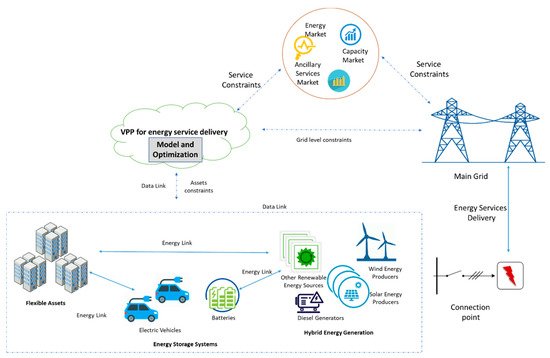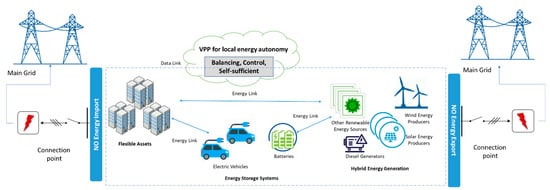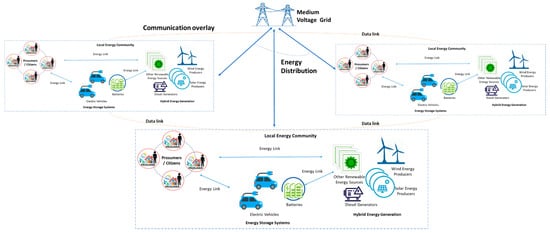Virtual power plants (VPPs) are promising solutions to address the decarbonization and energy efficiency goals in the smart energy grid. They assume the coordination of local energy resources such as energy generation, storage, and consumption. They are used to tackle problems brought by the stochastic nature of renewable energy, lack of energy storage devices, or insufficient local energy flexibility on the demand side. VPP modeling, management, and optimization are open to research problems that should consider, on one side, the local constraints in the operation of the energy resources and power flows and the energy grid’s sustainability objectives on the other side. There are multiple goals to create a VPP, such as to deliver energy services on a market or to the grid operator, to operate a microgrid in autonomy decoupled from the main grid, or to sustain local energy communities.
- virtual power plants
- smart grid optimization
- energy efficiency
1. Introduction
The concept of virtual power plants (VPPs) has been proposed and used lately as a solution for assuring an affordable, secure, and steady supply of energy in the smart grid [1][3]. It aims at combining and coordinating energy production with storage and consumption resources featuring controllable loads in an optimal way to meet renewable integration or energy costs minimization objectives. The associated optimization problem is usually addressed in the literature using various heuristics [2][4]. VPPs consider the predicted energy demand and production values for different resources, the operational, power flow, and cost constraints. They virtually aggregate resources to participate in energy markets, plan their operation in advance to deliver energy services, aggregate energy profiles for a steady supply and provide demand response services.
There are many works that that focus on creating such VPPs and optimally interacting them in various smart energy grid scenarios [3][4][5,6]. At the same time there are multiple ways to create a VPP that offer solutions for the energy market such as energy service delivery, energy autonomy, energy community, energy management or energy optimization, each of them with different purposes and steps to achieve a balance in the markets [1][3]. In order to establish which is the best approach for different situations, a requirements engineering solution has to be used where the starting point is the scenarios that describe the issue, in this case the energy consumption, and how to ensure stability and balance in the energy market, and the solution for it, represented in this case by the energy that can be provided from renewable resources which can sustain the economy and the market if a VPP is created in the architecture.
2. VPP Concept and Technology

2.1. Digital Twins’ Models
3.1. Digital Twins’ Models
2.2. Energy Forecasting
3.2. Energy Forecasting
The forecasting of energy demand, generation, and energy prices are fundamental inputs of the VPP management and optimization problem [21][22]. The prediction accuracy impacts the quality of the VPP solution; thus the uncertainty should be considered in the optimization problem formulation [22][55]. The stochastic nature of renewable energy generation and volatility of energy prices are limiting factors for VPP participation in energy markets [23][1]. Therefore, it is important to improve the quality of the forecasting models and techniques to lower as much as possible the impact of these uncertain parameters on the optimization problem [24][23]. Most promising in energy forecasting are artificial neural networks using long short-term memory (LTSM), convolutional neural networks (CNN), multi-layer perceptron (MLP), or recurrent neural networks (RNN) to achieve more accurate energy predictions [25][27]. Lately, ensemble-based approaches are also providing good forecasting results. For example, hybrid energy forecasting models are reported based on CNN and LTSM [26][28], two-hidden-layer LSTM and two-hidden-layer CNN [27][29], CNN-LSTM-RNN hybrid networks [28][30], and LTSM-RNN [29][31] hybrid models.2.3. Optimization and Coordination
3.3. Optimization and Coordination
The optimal virtual aggregation of energy assets is a complex constraint satisfaction problem addressed using different heuristics [30][62] considering local and energy grid sustainability objectives [31][35]. Relaxation of time constraints is possible in the case of VPP operation on the day-ahead energy markets allowing the implementation of cloud-based optimization solutions [32][36]. Various heuristics are defined for minimizing the VPP operational cost and maximizing the energy profit of energy assets [1][33][34][3,37,38]. Stochastic programming models are defined for VPP management and portfolio optimization under various objectives [35][36][39,40]. Moreover, multi-criteria optimization heuristics are investigated for VPP portfolio optimization to provide simultaneously cross-sector combined services for increased flexibility provisioning and to provide a transparent, verifiable, and trustworthy management framework [37][38][41,42]. Nevertheless, the decentralization of VPP coordination is only partially addressed in the literature even though it is a promising solution for better and timely consideration of local energy constraints [37][39][41,43]. Local density, power flows, administrative, and economic or social factors are criteria considered for VPP optimization processes [40][44]. There is a strong need for decentralized decision support systems on energy assets coordination in community-level VPP energy assets considering data on local sustainability goals, assets size, communication efficiency or latency, local typology, and remuneration schemes [41][45].32. VPP Applications in Smart Grids
The main identified research works are briefly presented and classified according to the VPP usage and applicability in specific smart grid energy management scenarios or strategies:-
VPP coordinates energy resources for collectively providing energy services in different markets or directly to interested stakeholders such as a DSO;
-
VPP coordinates energy resources for local energy autonomy to achieve an optimal balance between the demand and supply and to minimize energy exchanges among microgrids and the main grid;
-
VPP coordinates energy resources for the optimal implementation of sustainable energy communities considering in addition to energy aspects the local economic and social factors.
3.1. Energy Services Delivery
2.1. Energy Services Delivery
In modern smart grids, one important problem is system stability [5][2]. The grid can benefit from energy services as a solution to keep the power supply stable [6][109]. The services can be used to ensure that the energy demand, flexibility, or storage capabilities are used efficiently. The main role of a VPP in this context is to facilitate the prediction of the energy demand and generation of power from renewable sources such as wind, sun, etc. [21][31][22,35]. Using these estimations, the VPP coordinates the remote control of the spread devices that are dealing with these issues to offer energy services [3][5]. Different services may be provided by the VPPs depending on the market type [9][73] (see Figure 24). A VPP may interact with the energy market to buy energy when the prices are low and charge energy storage systems and sell the energy surplus when prices are high by adjusting the demand and discharging energy from the batteries [42][65]. The VPP will act as an intermediary between the energy resources in its portfolio and the energy market while addressing market or policy barriers. In the balancing market, the VPP can provide capacity for power plants that cannot meet their original commitment [42][65]. In the ancillary services market, the VPP may provide near real-time services such as frequency regulation [42][65].
3.2. Local Energy Autonomy
4.2. Local Energy Autonomy

3.3. Energy Communities’ Sustainability
4.3. Energy Communities’ Sustainability

